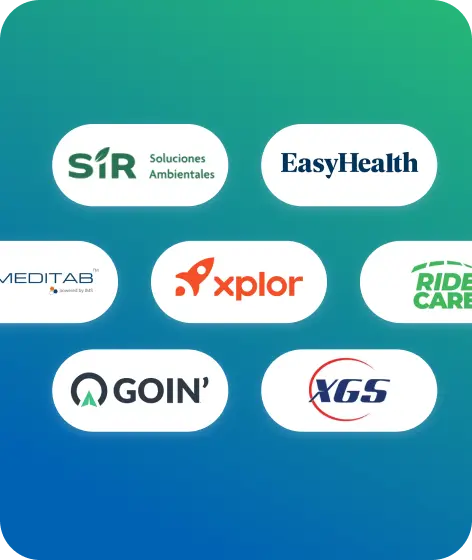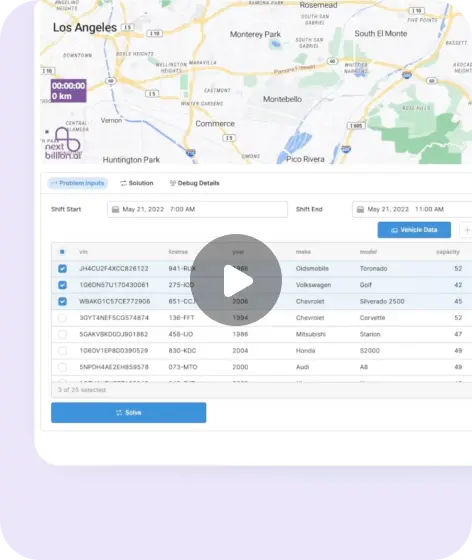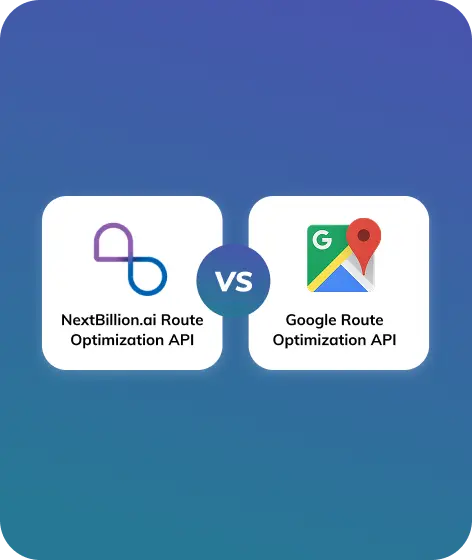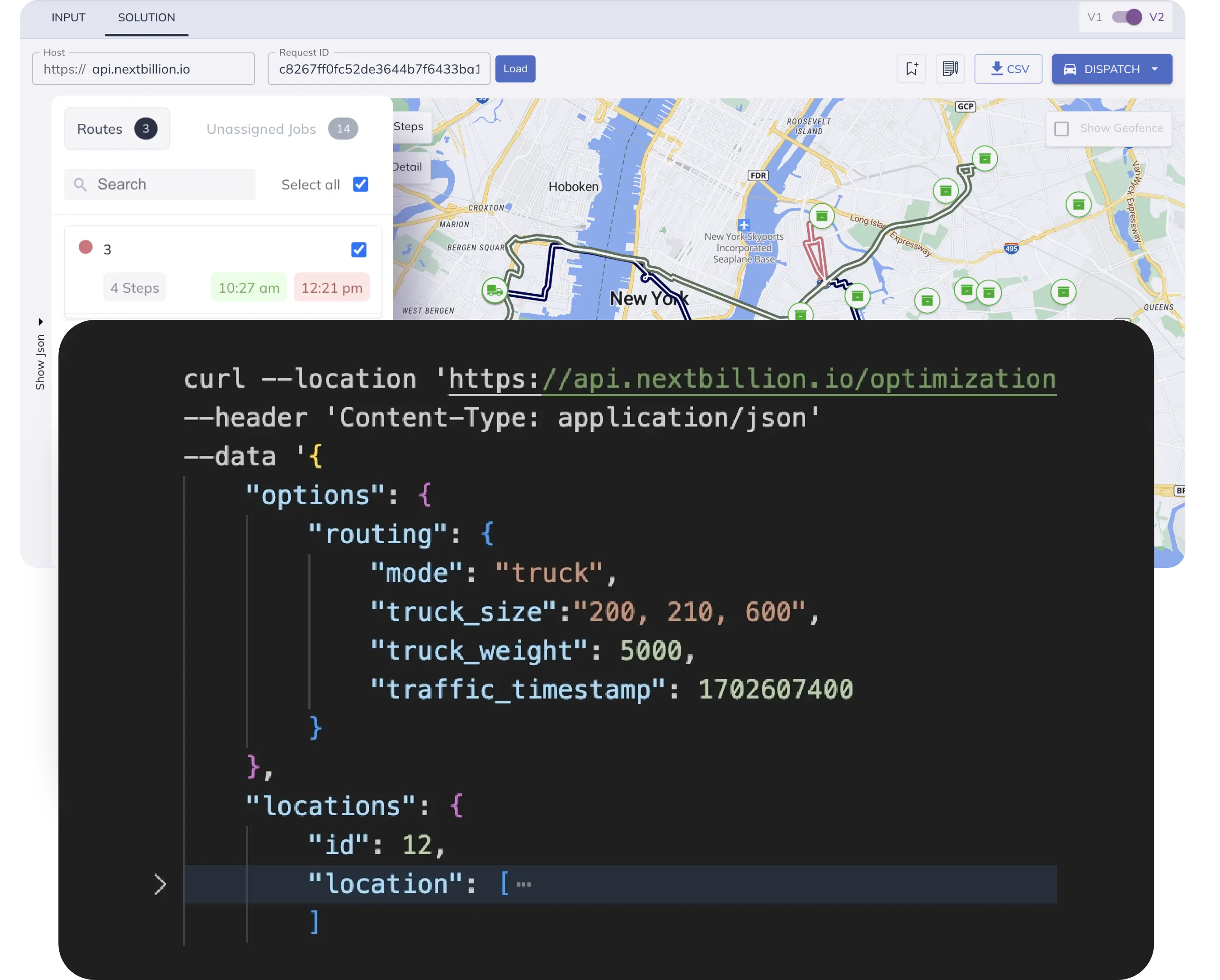Table of Contents
Gauging the five best distance matrix APIs available in the market is like presenting the best options for your business on a platter for instant decision-making. With distance matrix APIs gaining so much popularity among businesses that thrive on logistics, it’s not a surprise that companies have scaled up their APIs to perform better and offer superlative features.
As we know, Distance matrix APIs are essential tools for a wide range of businesses that rely on transportation and logistics. These include food and grocery delivery services, ride-hailing and ride-sharing companies, micro mobility providers, e-commerce platforms, logistics firms, and fleet management operations.
These industries, among others, depend on distance matrix APIs to streamline their operations. By leveraging these APIs, you can enhance overall efficiency, expand operational scale, improve predictability in services, and ultimately increase your profitability.
In essence, distance matrix APIs serve as a key to optimizing transport-based services stay competitive in any.
Read on to explore the five best distance matrix APIs options that you can use for scaling your business.
Where are Distance Matrix APIs used?
Distance Matrix APIs are web services that calculate optimal distances and journey times between multiple origins and destinations. You can use these across a wide spectrum, from optimizing fleet operations to developing gravity models and enhancing B2C search functionality. The market for such services is robust, with numerous providers like NextBillion, Google, Mapbox, TomTom and Distance Matrix offering comparable features.
When the choices seem to be many, selecting the right Distance Matrix API can be challenging. Though many providers offer similar core functionalities, they often differentiate themselves through nuanced features that can be difficult to evaluate at first glance. This similarity in basic offerings, coupled with subtle variations in advanced features, can make direct comparisons between providers a complex task.
Before we go on to understanding what we need to look for in a distance matrix API, here are some use cases where these APIs are used.
| Use Case | Description |
| Logistics Management | Compute inter-location distances and travel times to optimize efficiency in rote planning and scheduling. |
| Fleet Management | Monitor fleets with different vehicles and optimize travel routes based on real-time traffic situations, diversions or any risks involved. |
| Location-based marketing | Use proximity-based marketing by calculating customer-to-store distances for targeted campaigns. |
| Ride-hailing & Delivery Services | Calculate fares and ETAs while optimizing driver routes for efficient delivery of food (for example) and ride-hailing services. |
| Direction to Locations | Measure distances between locations such as hospitals, schools, and shopping areas. |
Benefits of Distance Matrix API
Optimized delivery time
On-demand deliveries require precise timing for delivery. Who would want to receive cold food after waiting for a long time? That’s never an acceptable scenario. In cases that require routes and distances to be carefully optimized, distance matrix APIs come of use. With this API, you can ensure smooth operations of delivery of perishable goods (apart from any other product).
This API is a great companion for drivers and managers to ensure that customers are happy with the on-time delivery, everytime.
Efficient process planning
In industries such as e-commerce, products are delivered on a large scale, every minute. This scale of operations can be easily and effortlessly optimized using distance matrix API. You can manage, schedule and execute processes in the most cost-intensive manner.
Delivery has to be planned like clockwork. No customer likes late delivery or a missed delivery. Optimizing work with a team of drivers, batching and sequencing of orders is the real reason for efficiency. With every delivery monitored and tracked, this API makes your processes simpler and faster.
Optimizing Routes
Large businesses dealing with larger fleets of trucks would immediately understand the need to optimize routes for long distances. You have to ensure that these trips are optimized to ensure lesser fuel is used and time is saved. Such large fleets involve very long distances and several stops along the way.
With a distance matrix API, you can sequence multiple stops. The distances and ETAs for each stop are used as inputs to optimize the most efficient possible route for the drivers. This largely helps in saving cost, time and efforts.
Factors to consider while choosing a Distance Matrix API
There are numerous players in the market for Distance Matrix APIs and it is definitely overwhelming to process and decipher the details of all of them. Though the usage limits, pricing and results are what matter, every feature could turn out to be important for you. In this article, we’ll help you get the crux of the best five Distance Matrix APIs and key differentiators.
Let’s take a look at some important factors to consider while choosing a distance matrix API for your business needs.
Factor 1: Size of operation
Your business size and the scale of operations is a crucial pointer for selecting an API that suits your exact requirement. You can start by assessing the fleet size and the typical distances and locations that would be considered for delivery. The number of stop-overs, connecting points, repeat routes and the kind of vehicles are also important to consider.
If your business relies on large fleets and your business is constantly evolving and expanding, then the size of the matrix is key. The bigger the operation, the bigger the matrix should be.
Custom features
Every business is unique, even if they are from the same industry. Distance matrix APIs not only calculate optimal distance and time, but also help businesses in improving productivity by chipping off unwanted excess time. For this, you must choose an API that is highly-customizable, robust and reliable. The API should also be able to ingest and collate from relevant proprietary and external data to deliver optimal output.
Customization also means that you should be able to handle individual and unique tasks, while handling several other requests, all at the same time. Distances, load, environment are all parameters that change from project to project. As it is evident, customization is mandatory.
Deployment mode
Deployment mode and considerations are as important as looking at the other relevant features in a distance matrix API. Is the API independent of cloud providers or do they communicate only with certain environments? This question can sort your deployability issues instantly. When the API can talk to only a certain cloud provider, it becomes inconvenient for you to replan or re-think your existing infrastructure to accommodate the API.
Compatibility should be the least concern when choosing the best. An API that can be easily deployed without any compatibility constraints is a boon and is what you should look for.
High-performance
Isn’t this what we all look for? Be it load, intensity or distance, a high-performing distance matrix API is a requirement in every business. High-volume operations demand robust APIs capable of handling rapid, large-scale requests for tasks like real-time route optimization and data integration.
Performance has to be three-dimensional and versatile- always stepping up to the changing demands of the business. Once you pin down on the scale and size of your business requirement, you can start looking for the specifics in an API.
Cost
Of course cost is crucial. How affordable is the API as against the features it carries is a good way to look at.
Operationally, every business cost is directly related to the returns it can offer. A dynamic and robust API with a mix of features that cater to both large and small scale businesses is a rare find, but would be the best choice.
Apart from the API being affordable, it is wise to also measure and assess what each API offers.
The Best Five Distance Matrix APIs – Pros and Cons
The best
To boil down to a list of five best distance matrix APIs is never easy. As daunting as it sounds, we have picked the top five that have a considerable number of features to look out for.
Let’s deep dive into the list and comparisons right away.
1.NextBillion.ai
NextBillion.ai stands out as the world’s first mapping platform designed exclusively for enterprise applications. This platform was built from scratch with no compromises, distractions, or secondary objectives. By maintaining a singular focus on this specific segment, NextBillion.ai has engineered and optimized its solutions at every stage to achieve one primary goal: your sustained business success. This focus on enterprise needs sets NextBillion.ai apart in the mapping technology landscape, offering tailored solutions that directly address the unique challenges and requirements of businesses.
Top features:
- Large distance matrix size
- Custom + real time data ingestion
- Vehicle specific profiles
- Cloud-agnostic, on premise deployment modes
Unique Selling Proposition
- Multiple origins and destinations at the same time
- Maximum requests 6000 per minute
- Maximum one to many matrix size 5000
The biggest differentiating factor in Nexbillion’s distance matrix API is its large matrix of 5000×5000 elements, which makes it an ideal choice for handling complex, large-scale routing calculations with ease. Comparing this with Google, Mapbox and TomTom, they all support a 25×25 matrix. Distancematrix.ai on the other hand matches with Nextbillion’s standards and offers 5000×5000 elements,
With every specific use case, NextBillion.ai’s API is absolutely customizable to suit that requirement. It is designed to leverage a wide array of contextual data relevant to your business operations. This flexibility allows for the incorporation of diverse factors to enhance the API’s output and optimize your vehicle-based operations.
The system can take into account variables such as vehicle specifications, cargo characteristics, travel time considerations, and even hyper-local elements like specific regional road regulations and temporary disruptions. By harnessing this breadth of data, the API can provide highly refined and tailored results, enabling more accurate and efficient planning for your unique operational needs. This adaptability makes the API a powerful tool for businesses seeking to fine-tune their logistics and transportation processes based on their specific context and requirements.
Route optimization and live data integration require a huge number of API calls in very short periods of time. In such a case, deployment plays a huge role. NextBillion.ai’s Distance Matrix API stands out with its on-premise deployment option, delivering enhanced performance compared to cloud-based alternatives. This local deployment capability results in a remarkable 20 times higher throughput and 3 times lower latency than typical cloud setups.
In contrast, other companies in comparison do not offer on-premise installation.This limitation constrains performance and causes latency and challenges associated with cloud infrastructure. Speed and responsiveness is critical.
Last but not least, affordability is always a concern. NextBillion.ai’s Distance Matrix API gives you flexible pricing options. This is an extremely workable model for any business – to pay for exactly what you choose.
You can pay based on:
- The ML model deployed
- The volume of API calls
And a fixed fee is charged for unlimited API calls for on-premise deployment.
Compared to all the five players in focus, NextBillion’s distance matrix API is the most dynamic, robust, reliable and cost-effective. You get more value for what you pay and clearly, this API stands as a winner.
Pros
Matrix size 5000
6000 requests per min
Multiple origins and destinations
Value for money
Cons
Not publicly available
Google’s mapping platform was pitched originally as a consumer-focused solution, designed to meet the everyday mapping needs of everyone, including business and general public. This approach proved highly successful, allowing Google to rapidly capture mindshare and establish itself as the preferred mapping solution for consumers worldwide.
As a result, Google’s enterprise mapping solutions are essentially adaptations of their consumer offerings, modified and reskinned to suit business needs. This evolution from consumer to enterprise solutions distinguishes Google’s approach from platforms built specifically for business applications from the ground up.
Google, though a well-known name, has been offering its distance matrix API with basic features that most companies deliver, with some constraints.
Pros
Calculate travel time based on current traffic conditions
Specify which side of the road the route should pass
Cons
Maximum of 25 origins or 25 destinations per request
Maximum 100 elements per server-side request.
Maximum 100 elements per client-side request.
Mapbox
Mapbox focuses on catering to developers, with ease of use and integration as their primary objectives. By prioritizing the seamless deployment of their solutions across a wide range of applications with minimal adjustments, Mapbox is a preferred choice among systems developers.
Their emphasis is more on developer-friendly features and flexibility. They offer features significant in the mapping technology market, particularly to those who require straightforward implementation and ease-of-use in their mapping tools.
Mapbox API calculates optimal routes for driving, walking, and cycling using traffic- and incident-aware routing, and also provides turn-by-turn instructions.
Pros
Calculate routes for electric vehicles with optimal charging stops as well as battery prediction
Provides turn-by-turn instructions
Caters to developers
Easy integration
Cons
Maximum of 25 origins or 25 destinations per request
Distancematrix.ai
Distance Matrix API offers solutions for calculating route durations, incorporating real-time traffic conditions for accuracy. The API, like all others, accommodates various modes of transportation including driving, walking, bicycling, and public transit. It goes beyond simple distance calculations by providing forecasted travel times based on specified departure and arrival times. Rapid response is one of their distinct features with responses in less than a second, ensuring quick and efficient route planning for a wide range of applications.
Distance Matrix API’s request-and-response format is similar to Google’s Distance Matrix API.
Pros
Route duration based on real-time traffic
Forecast travel times based on departure and arrival times
Geocoding API
Cons
100 elements per request
TomTom
This API enables you to generate a matrix of route summaries for a set of predefined routes, each specified by origin and destination locations. It calculates the routing cost from each origin to every given destination, effectively creating a table where origins and destinations serve as column and row headers respectively. The API calculates two primary costs for each route: travel times and distances. These computed costs provide valuable insights that can be used to determine which routes warrant further detailed calculation using the Routing API suite, allowing for efficient and informed decision-making in route planning and optimization processes.
Pros
API for multiple destinations
Fuel consumption is estimated
Deviations and alternative routes
Corrected and aligned data with points matched to the road
Cons
Matrix size 2500
Making the Right Choice for your Business
After comparing and gauging different APIs, it’s clear and evident that Nextbillion’s API has a strong list of features that make it an easy choice for businesses.
Remember that while selecting an API, you will have to consider different use cases and usage profiles. For example, let’s consider a route scheduling application that involves large many-to-many matrices.
In such a scenario, a company with a large fleet has to build a schedule of visits for each engineer based on an efficient routing calculation. We need to consider the driving times from each engineer to each destination. Ideally, as a business, you need to calculate a matrix of each engineer to the customer destination.
If you are looking for a provider to power a location-based search on a Web application, Nextbillion has limits up to 6000 per minute, which is the highest you can find. Similarly, if you look at just the cost factor, Distance Matrix API and Tom Tom offer competitive prices with some compromises to features.
TomTom allows synchronous requests with a limit of 200 locations per request, and a maximum of 10 requests per minute. This is quite a constraint when the business has large operations and requires quick responses.
Nextbillion.ai’s distance matrix API expands out of the restrictive 25×25 matrix limit that forces estimation in small batches.It significantly outperforms the other competitors in terms of scale and capacity. Nextbillion’s API can handle a much larger matrix, supporting up to 5000×5000 elements in a single call. This substantial increase in processing capacity allows for more comprehensive and complex route calculations, making it particularly valuable for businesses dealing with large-scale logistics operations or those requiring extensive route optimization across numerous locations.
Nextbillion’s powerful customization feature sets us apart from conventional solutions. It can analyze your organization’s historical operational data, including driver behaviors, speed profiles, preferred routes, travel times, and frequently visited points of interest. This analysis allows the API to tailor its output specifically to your business needs and unique operational intricacies. The system’s adaptability means that as you feed more relevant data into the API, its performance becomes increasingly fine-tuned to your specific operations. This results in a highly personalized tool that evolves with your business, continuously improving its accuracy and relevance to your particular use cases.
NextBillion.ai offers exceptional flexibility in API deployment through its cloud-agnostic feature, allowing you to run the API on any cloud service you prefer. This versatility enables seamless integration with your existing infrastructure, avoiding disruptions and unnecessary expenses.
However, the on-premise deployment option takes this flexibility even further, offering significant advantages. By hosting the API on your in-house infrastructure, you can achieve performance improvements, including up to 20 times higher throughput and 3 times lower latency compared to cloud deployments. This on-premise solution also gives you complete control over the API deployment, by cutting the dependence on external cloud providers for server maintenance or customizations. This level of control and performance optimization makes the on-premise option particularly useful for businesses with specific security requirements or those seeking to maximize API performance.
Look No Further
Nextbillion’s distance matrix API is the best choice for any business, of any nature. Having analyzed four other APIs that are available in the market, Nextbillion does stand out for all the right reasons.
With the high-level of performance and flexibility that we saw in Nextbillion’s API, you have the ability to scale according to your needs without concerns about whether your distance matrix API can handle operational demands. Additionally, on-premise deployments offer unlimited API calls at a fixed price, helping to control costs even as you scale.
We have presented the best five distance matrix APIs in the market with a clear indication of which is better than the best.
Ready to get started?
Request a DemoTable of Contents





